Investigation of Opening and Closing Water Boundary Conditions on Frost Damage Development in Concrete
Abstract
:1. Introduction
2. Experimental Program
2.1. Materials
2.2. Mixture Proportions and Specimen Preparation
2.3. Vacuum Water Saturation Test
2.4. Water Absorption Test
2.5. Sealing of Specimens
2.6. Freeze–Thaw Cycle Test
2.7. Ultrasonic Pulse Velocity Test
2.8. Compressive Strength Test
3. Results and Discussion
3.1. Initial State Parameters of Specimens
3.2. Water Absorption
3.3. Ultrasonic Pulse Velocity
3.4. Compressive Strength
4. Prediction Model for Concrete Freeze–Thaw Deterioration
4.1. Theoretical Basis
4.2. Degradation of Ultrasonic Velocity
4.3. Correlation between Compressive Strength and Ultrasonic Pulse Velocity
4.4. Damage Prediction Model
5. Conclusions
- (1)
- Continuous water replenishment in concrete expands existing internal cracks and initiates new ones. Although complete damage prevention is unattainable, limiting water can partially reduce the rate of damage. Water limitation measures can extend the service life of concrete structures and reduce the frequency of repairs.
- (2)
- The pore structure characteristics are influenced by the water supply. In open conditions, unrestricted water ingress increases the capillary pore volume and extends the initial water absorption stage. Conversely, in closed conditions, pore structure disruption is minimal.
- (3)
- Ultrasonic velocity and compressive strength tests confirm that limiting water absorption effectively mitigates freeze–thaw damage, thereby protecting concrete from severe frost damage.
- (4)
- A predictive model for concrete freeze–thaw deterioration, developed using regression analysis and relative dynamic modulus theory, forecasts ultrasonic pulse velocity and compressive strength during hydration based on the number of FTCs experienced under open and closed conditions.
Author Contributions
Funding
Data Availability Statement
Conflicts of Interest
References
- Gong, F.Y.; Sicat, E.; Ueda, T.; Zhang, D.W. Meso-scale mechanical model for mortar deformation under freeze thaw cycles. J. Adv. Concr. Technol. 2013, 11, 49–60. [Google Scholar] [CrossRef]
- Gong, F.Y.; Sicat, E.; Zhang, D.W.; Ueda, T. Stress analysis for concrete materials under multiple freeze-thaw cycles. J. Adv. Concr. Technol. 2015, 13, 124–134. [Google Scholar] [CrossRef]
- Gong, F.Y.; Wang, Y.; Zhang, D.; Ueda, T. Mesoscale simulation of deformation for mortar and concrete under cyclic freezing and thawing stress. J. Adv. Concr. Technol. 2015, 13, 291–304. [Google Scholar] [CrossRef]
- Bao, J.W.; Wei, J.; Zhang, P.; Zhuang, Z.J.; Zhao, T.J. Experimental and theoretical investigation of chloride ingress into concrete exposed to real marine environment. Cem. Concr. Compos. 2022, 130, 104511. [Google Scholar] [CrossRef]
- Li, P.F.; Wang, H.Y.; Nie, D.; Wang, D.Y.; Wang, C.Z. A method to analyze the long-term durability performance of underground reinforced concrete culvert structures under coupled mechanical and environmental loads. J. Intell. Constr. 2023, 1, 9180011. [Google Scholar] [CrossRef]
- Sun, X.J.; Wang, S.Q.; Jin, J.P.; Wang, Z.; Gong, F.Y. Computational methods of mass transport in concrete under stress and crack conditions: A review. J. Intell. Constr. 2023, 1, 9180015. [Google Scholar] [CrossRef]
- Sun, W.J.; Ma, J.Z.; Jin, J.X.; Li, S.H.; Liu, Q.; Wang, H.B. Quantitative study of the failure characteristics of sandstone with freeze–thaw damage: Insight into the cracking behavior. Rock Mech. Rock Eng. 2024, 1–20. [Google Scholar] [CrossRef]
- Gong, F.Y.; Ren, M.Q.; Maekawa, K.J.E.S. Simulation of spatially non-uniform frost damage in RC beams under various exposure and confining conditions. Eng. Struct. 2018, 176, 859–870. [Google Scholar] [CrossRef]
- Su, H.Z.; Xu, X.Y.; Zuo, S.L.; Zhang, S.; Yan, X.Q. Research progress in monitoring hydraulic concrete damage based on acoustic emission. J. Intell. Constr. 2023, 1, 9180024. [Google Scholar] [CrossRef]
- Wang, Z.; Yaseen, S.A.; Maekawa, K.; Leung, C.K.; Poon, C.S.; Li, Z.J. Performance assessment of sea-water fly ash cement paste with integrated physicochemical-geochemical simulation platform and experimental validation. J. Build. Eng. 2023, 79, 107802. [Google Scholar] [CrossRef]
- Zhang, Q.; Chen, M.H.; Gu, X.L.; Li, Y.Z.; Li, W.J.; Gong, J.X. Low-cycle fatigue properties and model for flexure-shear critical reinforced concrete columns considering cyclical damage effects. ASCE J. Struct. Eng. 2024, 150, 04024071. [Google Scholar] [CrossRef]
- Gong, F.Y.; Jacobsen, S. Modeling of water transport in highly saturated concrete with wet surface during freeze/thaw. Cem. Concr. Res. 2019, 115, 294–307. [Google Scholar] [CrossRef]
- Li, X.X.; Chen, S.H.; Xu, Q.; Xu, Y. Modeling capillary water absorption in concrete with discrete crack network. J. Mater. Civ. Eng. 2018, 30, 04017263. [Google Scholar] [CrossRef]
- Mao, J.H.; Xu, J.; Zhang, J.; Wu, K.; He, J.M.; Fan, W.J. Recycling methodology of chloride-attacked concrete based on electrochemical treatment. J. Clean. Prod. 2022, 340, 130822. [Google Scholar] [CrossRef]
- Wang, Y.; Xie, S.; Wang, Z.; Li, X.D.; Gong, F.Y.; Nagai, K.; Deng, J.; Ueda, T.; Hu, W.G. Experimental investigation on electrical response and mechanical performance of cementitious materials at low temperatures. Cem. Concr. Compos. 2023, 143, 105264. [Google Scholar] [CrossRef]
- Xia, P.; Yang, L.; Wang, S.Q.; Gong, F.Y.; Cao, W.L.; Zhao, Y.X. Improved freeze-thaw modification of recycled concrete aggregate originally from frost resistive concrete. Cem. Concr. Compos. 2023, 144, 105302. [Google Scholar] [CrossRef]
- Gong, F.Y.; Sun, X.J.; Takahashi, Y.; Maekawa, K.; Jin, W.L. Computational modeling of combined frost damage and alkali–silica reaction on the durability and fatigue life of RC bridge decks. J. Intell. Constr. 2023, 1, 9180001. [Google Scholar] [CrossRef]
- Xia, P.; Huang, Z.; Wang, S.Q.; Mao, J.H.; Liu, L.; Zhao, Y.X.; Gong, F.Y. A complete thermo-poromechanical model for freeze-thaw modification of recycled coarse aggregate considering deterioration of each component. Constr. Build. Mater. 2024, 421, 135626. [Google Scholar] [CrossRef]
- Chen, K.Y.; Wang, S.Q.; Wang, Y.; Wei, J.Y.; Wang, Q.H.; Du, W.; Jin, W.L. Intelligent design of limit states for recycled aggregate concrete filled steel tubular columns. Structures 2023, 58, 105338. [Google Scholar] [CrossRef]
- Hasan, M.; Okuyama, H.; Sato, Y.; Ueda, T. Stress-strain model of concrete damaged by freezing and thawing cycles. J. Adv. Concr. Technol. 2004, 2, 89–99. [Google Scholar] [CrossRef]
- Liu, D.; Tu, Y.; Sas, G.; Elfgren, L. Freeze-thaw damage evaluation and model creation for concrete exposed to freeze–thaw cycles at early-age. Constr. Build. Mater. 2021, 312, 125352. [Google Scholar] [CrossRef]
- Wang, S.Q.; Xia, P.; Wang, Z.; Meng, T.; Gong, F.Y. Intelligent mix design of recycled brick aggregate concrete based on swarm intelligence. J. Build. Eng. 2023, 71, 106508. [Google Scholar] [CrossRef]
- Yu, Z.X.; He, J.Y.; Wang, Y.; He, S.H.; Ueda, T. Accuracy analysis on CFRP-RC interfacial defects detected using electrical measurement: Influence of steel reinforcement. Constr. Build. Mater. 2024, 418, 134977. [Google Scholar] [CrossRef]
- Sicat, E.; Gong, F.Y.; Zhang, D.W.; Ueda, T. Change of the coefficient of thermal expansion of mortar due to damage by freeze thaw cycles. J. Adv. Concr. Technol. 2013, 11, 333–346. [Google Scholar] [CrossRef]
- Bentz, J.; Ferraris, D.P.; Wingpigler, C.F. Technical basis for CONCLIFE—Sorptivity testing and computer models building and fire research laboratory. In Service Life Prediction for Concrete Pavements and Bridge Decks Exposed to Sulfate Attack and Freeze-Thaw Deterioration; Building and Fire Research Laboratory, National Institute of Standards and Technology: Gaithersburg, MD, USA, 2001; Volume II. [Google Scholar]
- Bentz, D.P.; Ehlen, M.A.; Ferraris, C.F.; Garboczi, E.J. Sorptivity-based service life predictions for concrete pavements. In Proceedings of the 7th International Conference on Concrete Pavements, Orlando, FL, USA, 9–13 September 2001; pp. 181–193. [Google Scholar]
- Maekawa, K.; Fujiyama, C. Rate-dependent model of structural concrete incorporating kinematics of ambient water subjected to high-cycle loads. Eng. Comput. 2013, 30, 825–841. [Google Scholar] [CrossRef]
- Coussy, O.; Monteiro, P.J.M. Poroelastic model for concrete exposed to freezing temperatures. Cem. Concr. Res. 2008, 38, 40–48. [Google Scholar] [CrossRef]
- Hanjari, K.Z.; Kettil, P.; Lundgren, K. Modelling the structural behaviour of frost-damaged reinforced concrete structures. Struct. Infrastruct. Eng. 2013, 9, 416–431. [Google Scholar] [CrossRef]
- Qin, Q.; Zheng, S.S.; Li, L.; Dong, L.G.; Zhang, Y.X.; Ding, S. Experimental study and numerical simulation of seismic behavior for RC columns subjected to freeze-thaw cycles. Adv. Mater. Sci. Eng. 2017, 2017, 7496345. [Google Scholar] [CrossRef]
- Zhang, Q.; Wei, Z.Y.; Gu, X.L.; Yang, Q.C.; Li, S.Y.; Zhao, Y.S. Confinement behavior and stress-strain response of square concrete columns strengthened with carbon textile reinforced concrete (CTRC) composites. Eng. Struct. 2022, 266, 114592. [Google Scholar] [CrossRef]
- Bao, J.W.; Zheng, R.; Wei, J.; Zhang, P.; Xue, S.B.; Liu, Z.L. Numerical and experimental investigation of coupled capillary suction and chloride penetration in unsaturated concrete under cyclic drying-wetting condition. J. Build. Eng. 2022, 51, 104273. [Google Scholar] [CrossRef]
- Wang, Z.; Gong, F.Y.; Maekawa, K. Multi-scale and multi-chemo–physics lifecycle evaluation of structural concrete under environmental and mechanical impacts. J. Intell. Constr. 2023, 1, 9180003. [Google Scholar] [CrossRef]
- Mao, J.H.; Deng, R.Z.; Wang, Q.Y.; Wang, P.S.; Shi, Q.; He, J.M.; Jin, L.B. Chloride ion control of under-constructing concrete structure based on ECE with different electric field intensities. Constr. Build. Mater. 2023, 369, 130516. [Google Scholar] [CrossRef]
- Wang, S.Q.; Xia, P.; Chen, K.Y.; Gong, F.Y.; Wang, H.; Wang, Q.; Zhao, Y.; Jin, W. Prediction and optimization model of sustainable concrete properties using machine learning, deep learning and swarm intelligence: A review. J. Build. Eng. 2023, 80, 108065. [Google Scholar] [CrossRef]
- Xia, P.; Wang, S.Q.; Chen, K.Y.; Meng, T.; Chen, X.; Gong, F.Y. A recycling approach of natural stone from crushed concrete based on freeze-thaw modification and usage of spalling mortar as recycled fine aggregate. Constr. Build. Mater. 2024, 416, 135287. [Google Scholar] [CrossRef]
- Zhang, Q.; Zheng, N.H.; Gu, X.L.; Wei, Z.Y.; Zhang, Z. Study of the confinement performance and stress-strain response of RC columns with corroded stirrups. Eng. Struct. 2022, 266, 114476. [Google Scholar] [CrossRef]
- GB 175-2020; Common Portland Cement. China Standards Press: Beijing, China, 2020.
- JGJ 63-2006; Standards for Water Use in Concrete. China Architecture and Building Press: Beijing, China, 2006.
- ASTM C1585-04; Standard Test Method for Measurement of Rate of Absorption of Water by Hydraulic-Cement Concretes. ASTM International: West Conshohocken, PA, USA, 2004.
- Hall, C.; Yau, M.H.R. Water movement in porous building materials—IX. The water absorption and sorptivity of concretes. Build. Environ. 1987, 22, 77–82. [Google Scholar] [CrossRef]
- Li, W.; Pour-Ghaz, M.; Castro, J.; Weiss, J. Water absorption and critical degree of saturation relating to freeze-thaw damage in concrete pavement joints. J. Mater. Civ. Eng. 2012, 24, 299–307. [Google Scholar] [CrossRef]
- Fonseca, P.; Scherer, G. An image analysis procedure to quantify the air void system of mortar and concrete. Mater. Struct. 2015, 48, 3087–3098. [Google Scholar] [CrossRef]
- Quattrone, M.; Cazacliu, B.; Angulo, S.; Hamard, E.; Cothenet, A. Measuring the water absorption of recycled aggregates, what is the best practice for concrete production? Constr. Build. Mater. 2016, 123, 690–703. [Google Scholar] [CrossRef]
- Lao, J.C.; Huang, B.T.; Fang, Y.; Xu, L.Y.; Dai, J.G.; Shah, S.P.J.C. Research, Strain-hardening alkali-activated fly ash/slag composites with ultra-high compressive strength and ultra-high tensile ductility. Cem. Concr. Res. 2023, 165, 107075. [Google Scholar] [CrossRef]
- Duan, Z.H.; Li, B.; Xiao, J.Z.; Guo, W. Optimizing mix proportion of recycled aggregate concrete by readjusting the aggregate gradation. Struct. Concr. 2021, 22, E22–E32. [Google Scholar] [CrossRef]
- JGJ 55-2011; Specification for Mix Proportion Design of Ordinary Concrete. Ministry of Housing and Urban-Rural Development of the People’s Republic of China: Beijing, China, 2011.
- JGJ 52-2006; Standard for Technical Requirements and Test Method of Sand and Crushed Stone (or Gravel) for Ordinary Concrete. Ministry of Construction of the People’s Republic of China: Beijing, China, 2006.
- Smith, S.H.; Qiao, C.; Suraneni, P.; Kurtis, K.E.; Weiss, W.J. Service-life of concrete in freeze-thaw environments: Critical degree of saturation and calcium oxychloride formation. Cem. Concr. Res. 2019, 122, 93–106. [Google Scholar] [CrossRef]
- Wu, Z.; Wong, H.S.; Chen, C.; Buenfeld, N.R. Anomalous water absorption in cement-based materials caused by drying shrinkage induced microcracks. Cem. Concr. Res. 2019, 115, 90–104. [Google Scholar] [CrossRef]
- Chen, Y.L.; Tong, J.Z.; Li, Q.H.; Xu, S.L.; Gao, W.; Liu, X. Flexural behavior of novel profiled steel-UHTCC assembled composite bridge decks. J. Constr. Steel Res. 2024, 212, 108258. [Google Scholar] [CrossRef]
- Dong, H.; Gao, P.; Ye, G. Characterization and comparison of capillary pore structures of digital cement pastes. Mater. Struct. 2017, 50, 154. [Google Scholar] [CrossRef]
- Wang, S.Q.; Xia, P.; Gong, F.Y.; Zeng, Q.; Chen, K.Y.; Zhao, Y.X. Multi objective optimization of recycled aggregate concrete based on explainable machine learning. J. Clean. Prod. 2024, 445, 141045. [Google Scholar] [CrossRef]
- Fan, Q.X.; Jiang, X.C.; Wang, K.X.; Huang, C.X.; Li, G.; Wei, P.C. Cement grouting online monitoring and intelligent control for dam foundations. J. Intell. Constr. 2023, 1, 9180005. [Google Scholar] [CrossRef]
- Fakhri, M.; Siyadati, S.; Aliha, M. Impact of freeze–thaw cycles on low temperature mixed mode I/II cracking properties of water saturated hot mix asphalt: An experimental study. Constr. Build. Mater. 2020, 261, 119939. [Google Scholar] [CrossRef]
- Lao, J.C.; Ma, R.Y.; Xu, L.Y.; Li, Y.; Shen, Y.N.; Yao, J.; Wang, Y.S.; Xie, T.; Huang, B. Fly ash-dominated high-strength engineered/strain-hardening geopolymer composites (HS-EGC/SHGC): Influence of alkalinity and environmental assessment. J. Clean. Prod. 2024, 447, 141182. [Google Scholar] [CrossRef]
- Zhang, Q.; Cheng, G.; Zhao, H.T.; Li, W.J.; Zhu, H.Y.; Zhang, H.; Gu, X.L. Bond properties between polyvinyl chloride (PVC) tubes and wrapped textile reinforced fine concrete (TRC) shells. Constr. Build. Mater. 2024, 431, 136594. [Google Scholar] [CrossRef]
- Saladi, N.; Montanari, L.; Varga, I.; Spragg, R.; Graybeal, B. Assessing durability properties of ultra-high performance concrete-class materials. Mater. Struct. 2023, 56, 155. [Google Scholar] [CrossRef]
- Yu, C.Q.; Tong, G.S.; Tong, J.Z.; Zhang, J.W.; Li, X.G.; Xu, S.L. Experimental and numerical study on seismic performance of L-shaped multi-cellular CFST frames. J. Constr. Steel Res. 2024, 213, 108360. [Google Scholar] [CrossRef]
- Lu, J.; Liu, J.; Yang, H.; Wan, X.; Gao, J.; Zhang, J.; Li, P. Experimental investigation on the mechanical properties and pore structure deterioration of fiber-reinforced concrete in different freeze-thaw media. Constr. Build. Mater. 2022, 350, 128887. [Google Scholar] [CrossRef]
- Zhi, D.; Xia, P.; Wang, S.Q.; Gong, F.Y.; Cao, W.L.; Wang, D.M.; Ueda, T. RBSM-based mesoscale study of mechanical properties and frost damage behaviors for recycled fine aggregate concrete. Constr. Build. Mater. 2024, 416, 135136. [Google Scholar] [CrossRef]
- Zhang, Q.; Yang, Q.C.; Gu, X.L.; Jiang, Y. Study on axial compression properties of concrete columns wrapped with basalt textile-reinforced fine concrete (BTRC) jackets. Constr. Build. Mater. 2023, 363, 129809. [Google Scholar] [CrossRef]
- ASTM C597-09; Standard Test Method for Pulse Velocity through Concrete. ASTM International: West Conshohocken, PA, USA, 2009.
- Wang, R.J.; Zhang, Q.J.; Li, Y. Deterioration of concrete under the coupling effects of freeze–thaw cycles and other actions: A review. Constr. Build. Mater. 2022, 319, 126045. [Google Scholar] [CrossRef]
- Bao, J.W.; Wang, Y.W.; Zhang, H.R.; Li, S.G.; Zhang, P.; Qin, L.; Song, Q. Effect of loading-induced damage on chloride ingress behavior of recycled aggregate concrete: A comprehensive review. Cem. Concr. Compos. 2023, 141, 105123. [Google Scholar] [CrossRef]
- Zhao, Y.; Lian, S.L.; Bi, J.; Wang, C.L. Study on freezing-thawing damage mechanism and evolution model of concrete. Theor. Appl. Fract. Mech. 2022, 121, 103439. [Google Scholar] [CrossRef]
- Wang, Z.; Gong, F.Y.; Zhang, D.W.; Wang, Y.; Ueda, T. RBSM based analysis on mechanical degradation of non-air entrained concrete under frost action—A general prediction with various water cement ratio, lowest temperatures and FTC numbers. Constr. Build. Mater. 2019, 211, 744–755. [Google Scholar] [CrossRef]
- Zhao, H.D.; Yang, F.; Qian, X.; Tian, Y.; Yang, H.; Li, M.X.; Fang, Y.; Wang, J.L.; Ling, J.M. A bio-inspired mineral precipitation method to improve the freeze-thaw resistance of cement concrete pavement. J. Clean. Prod. 2023, 419, 138277. [Google Scholar] [CrossRef]





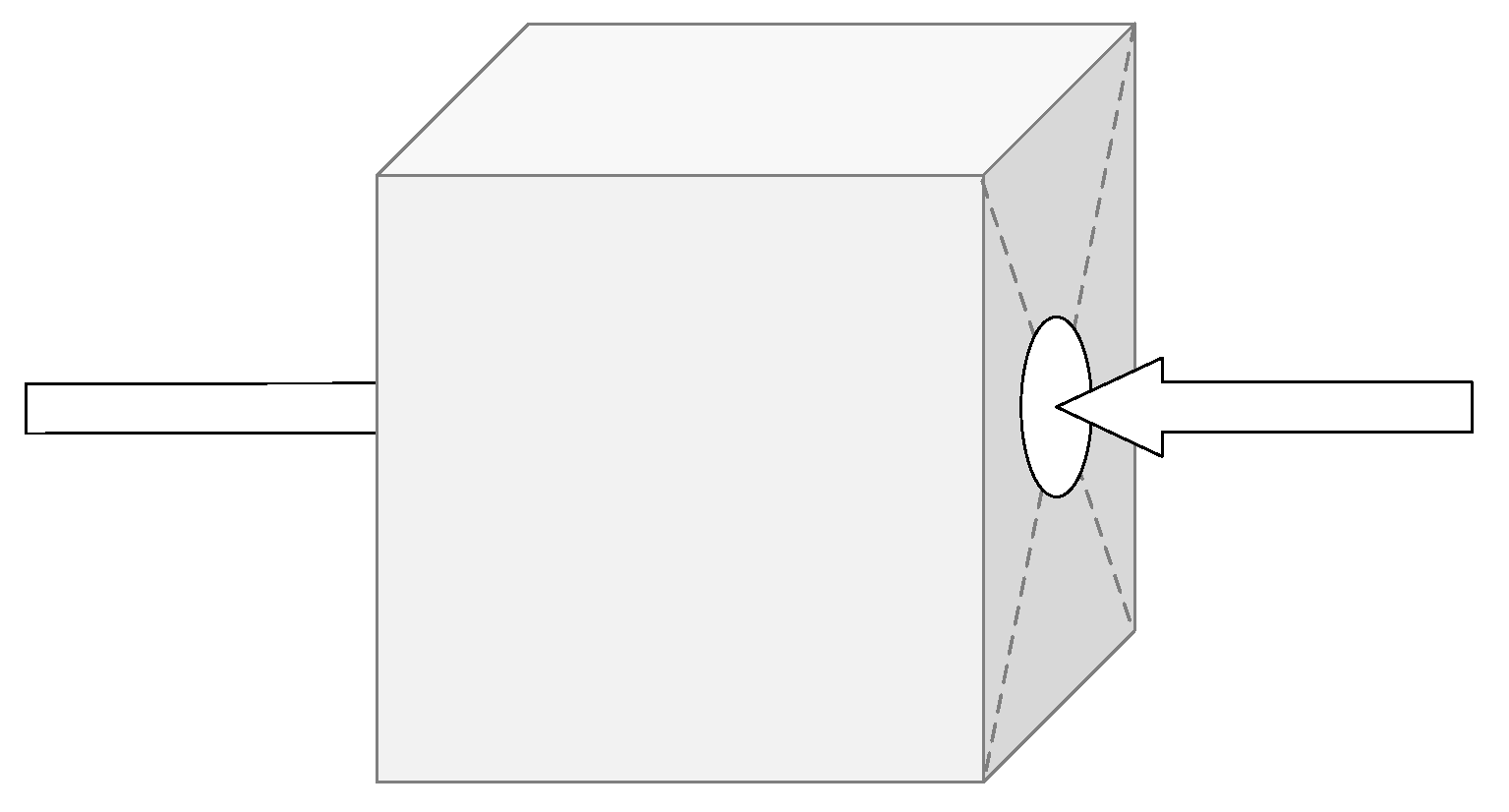

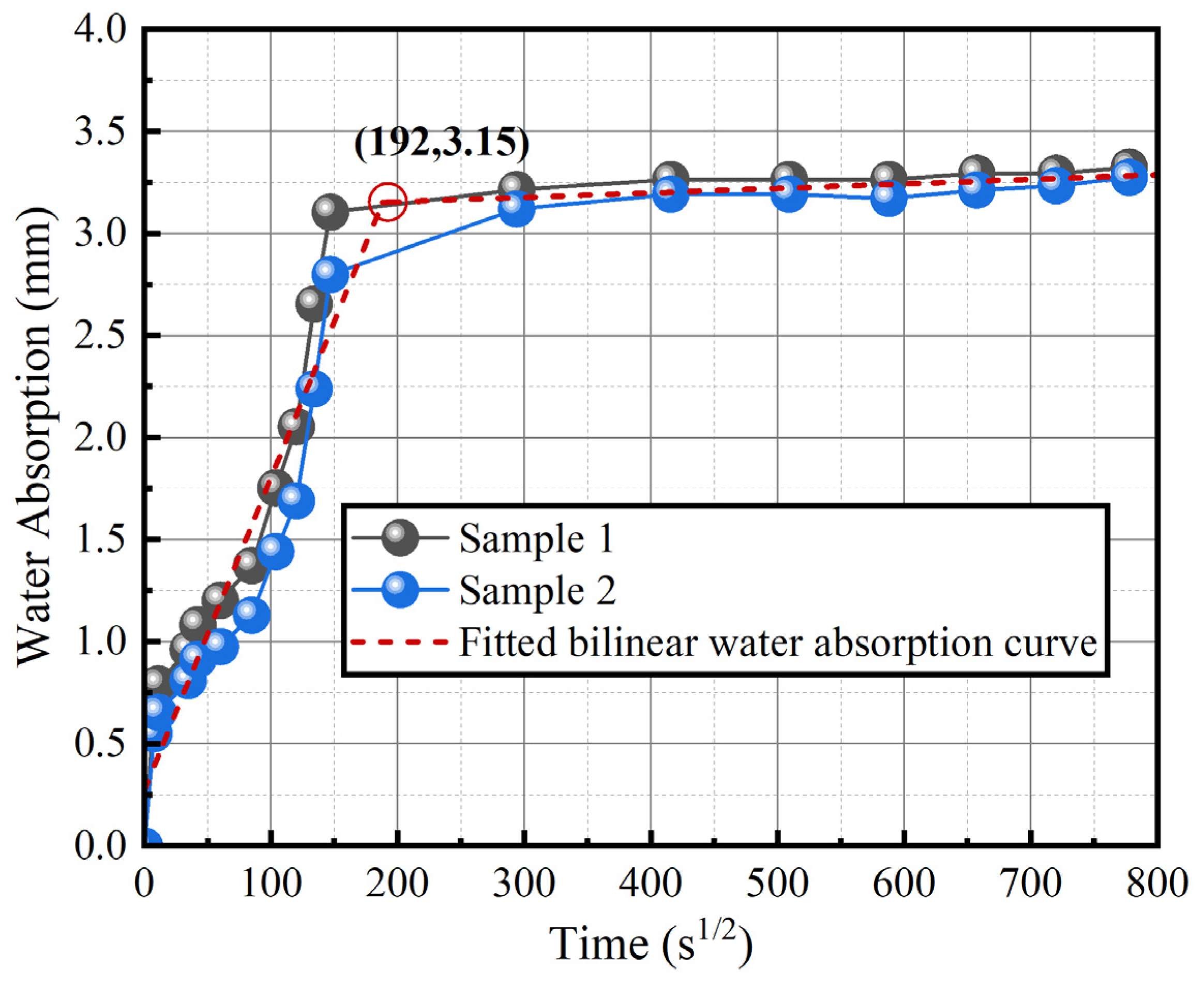
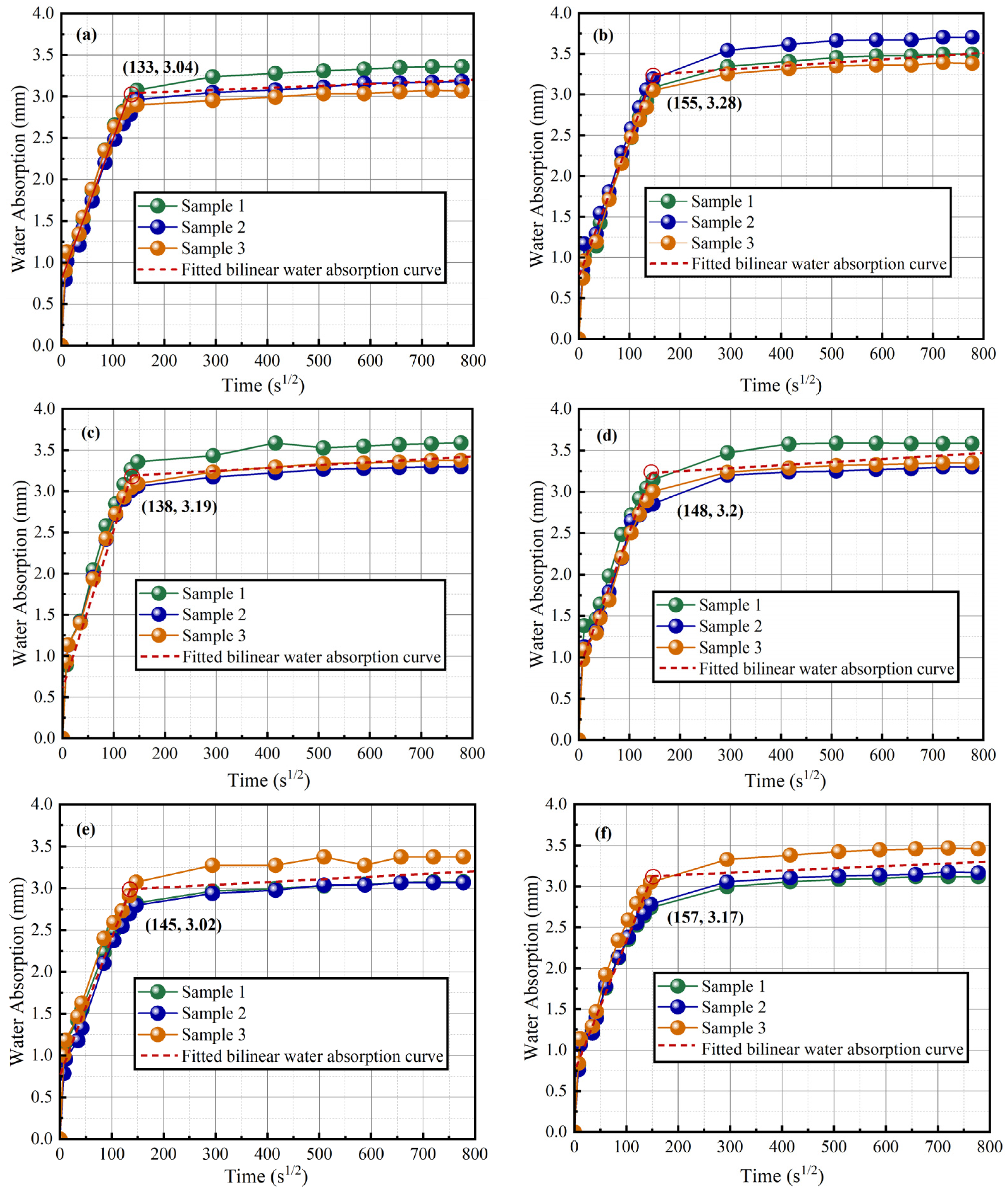
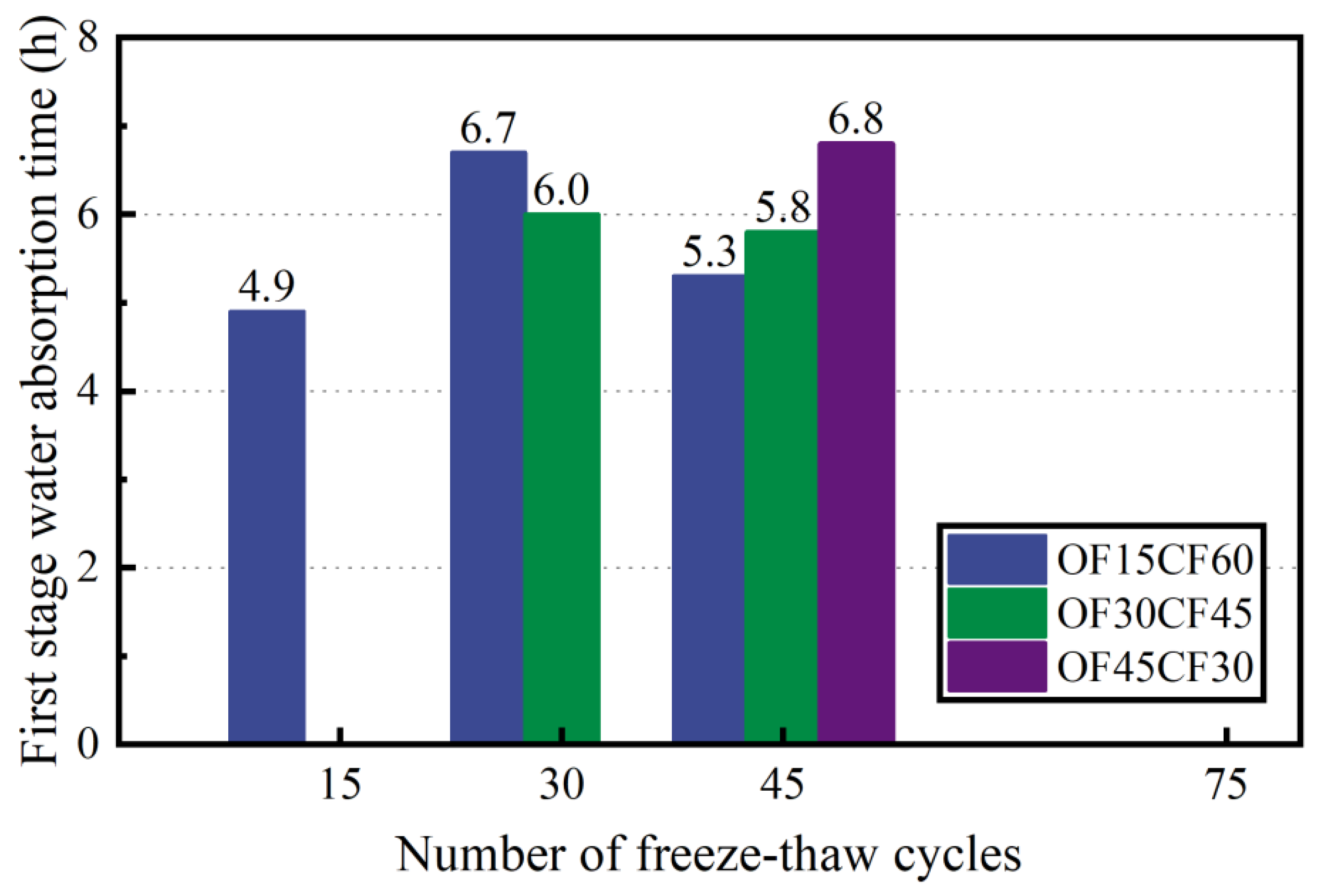


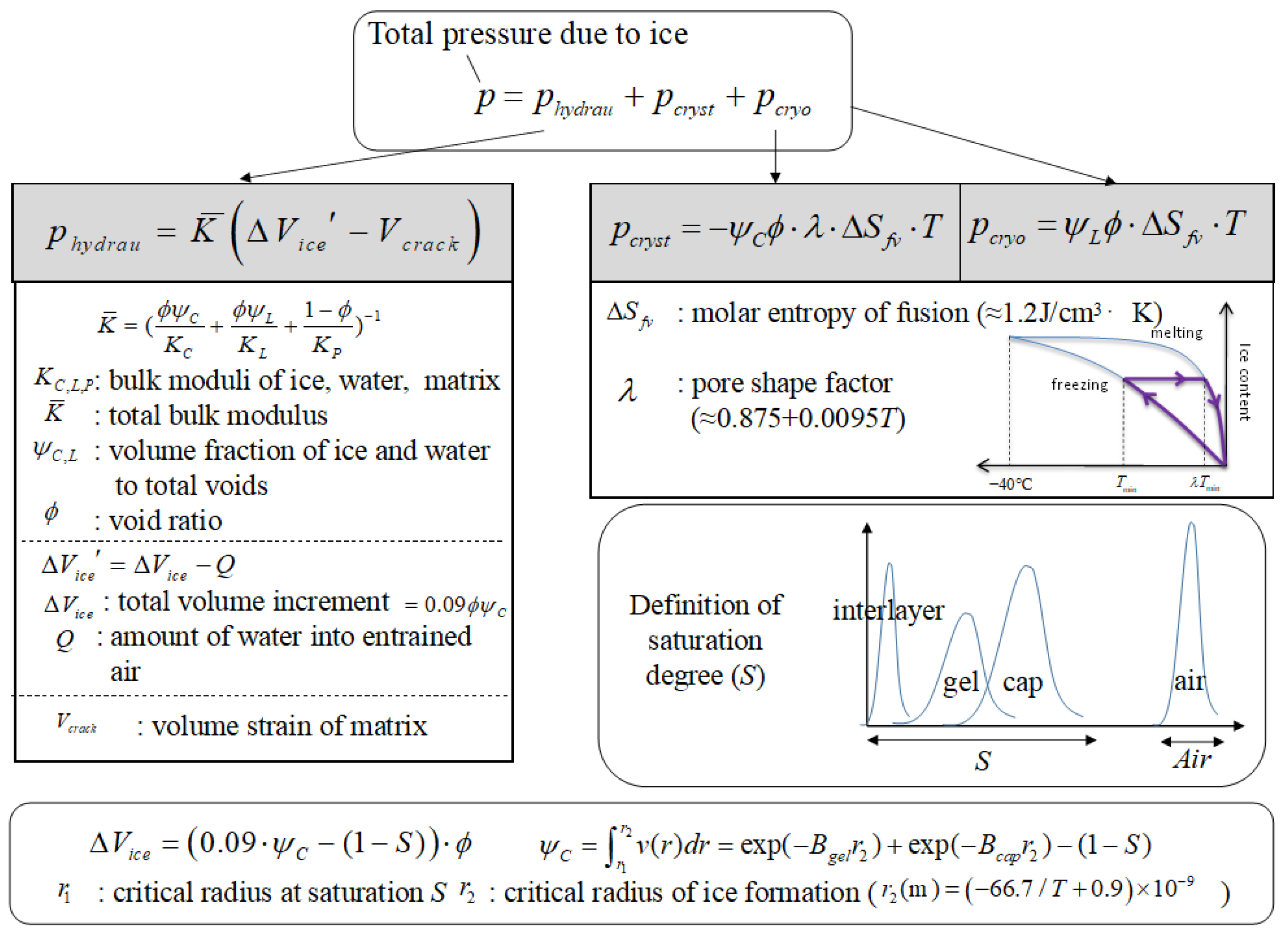
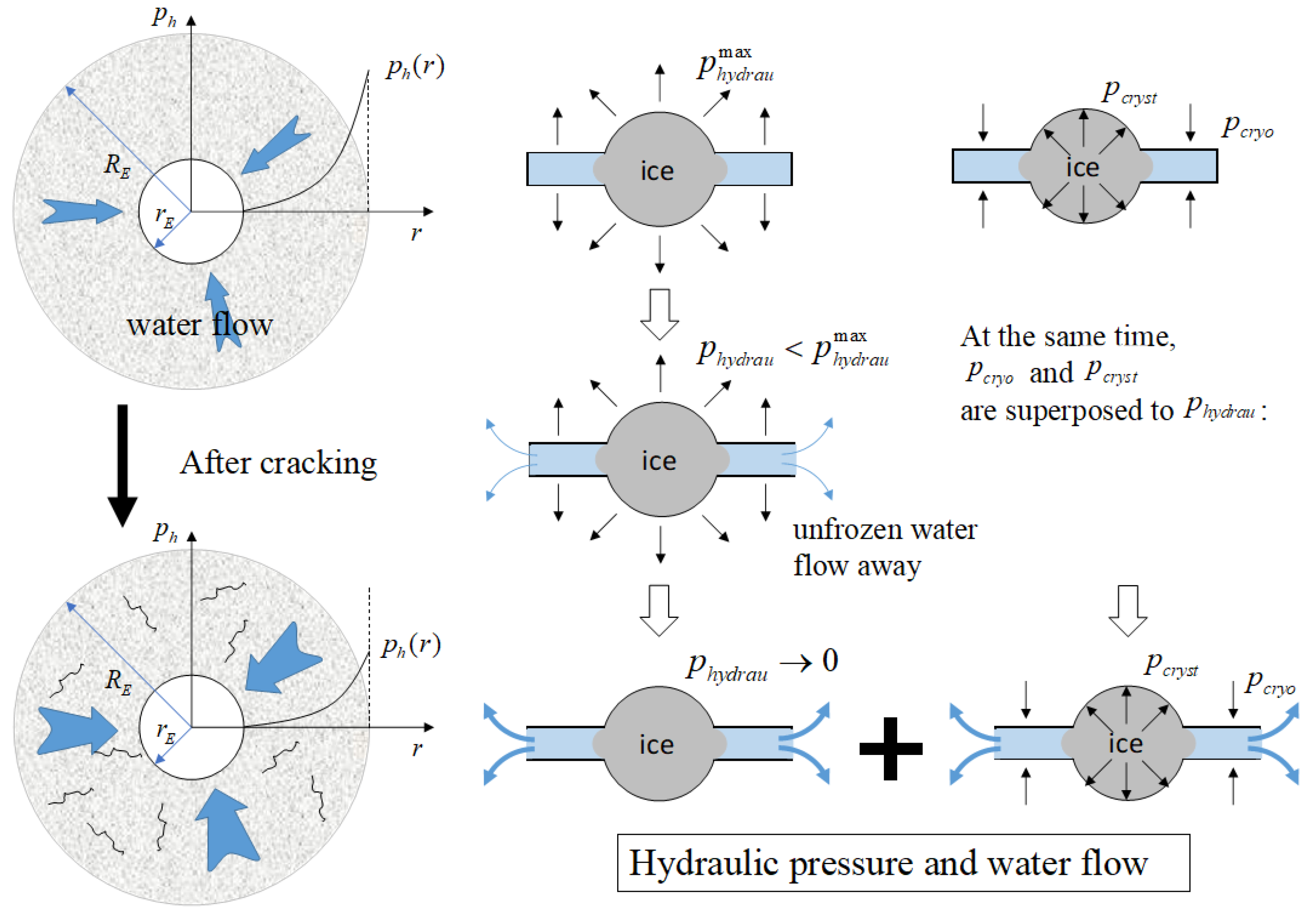
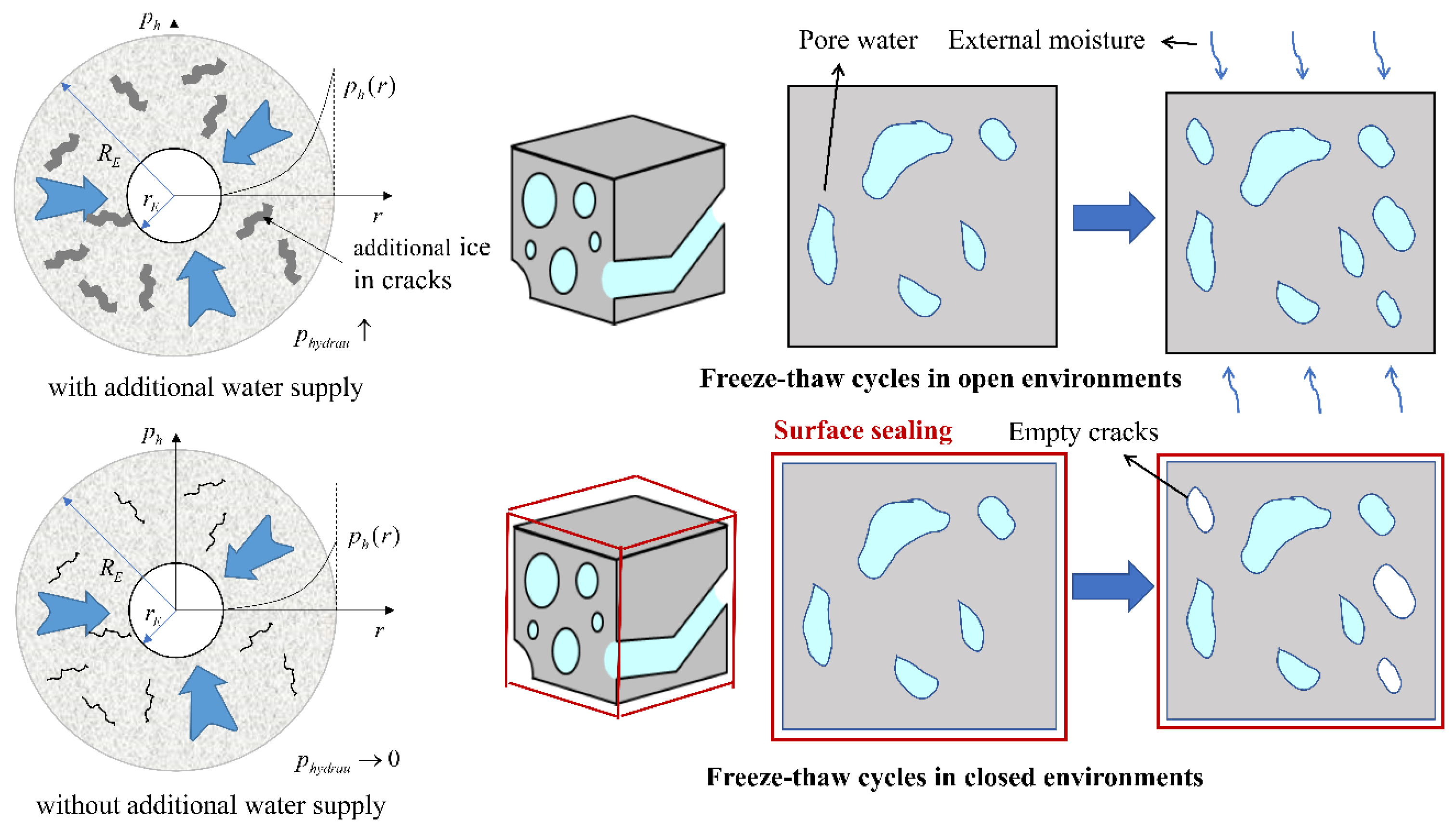
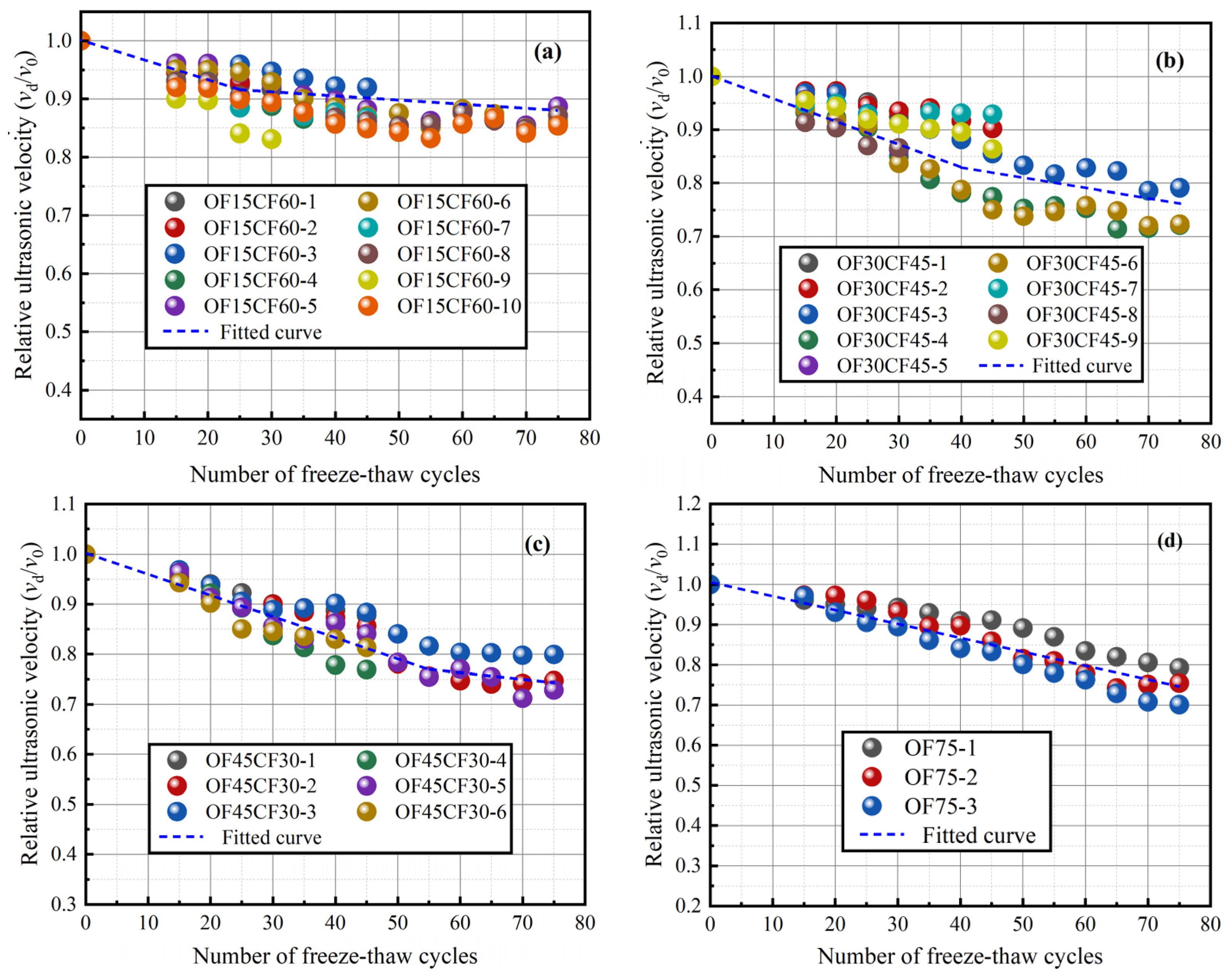
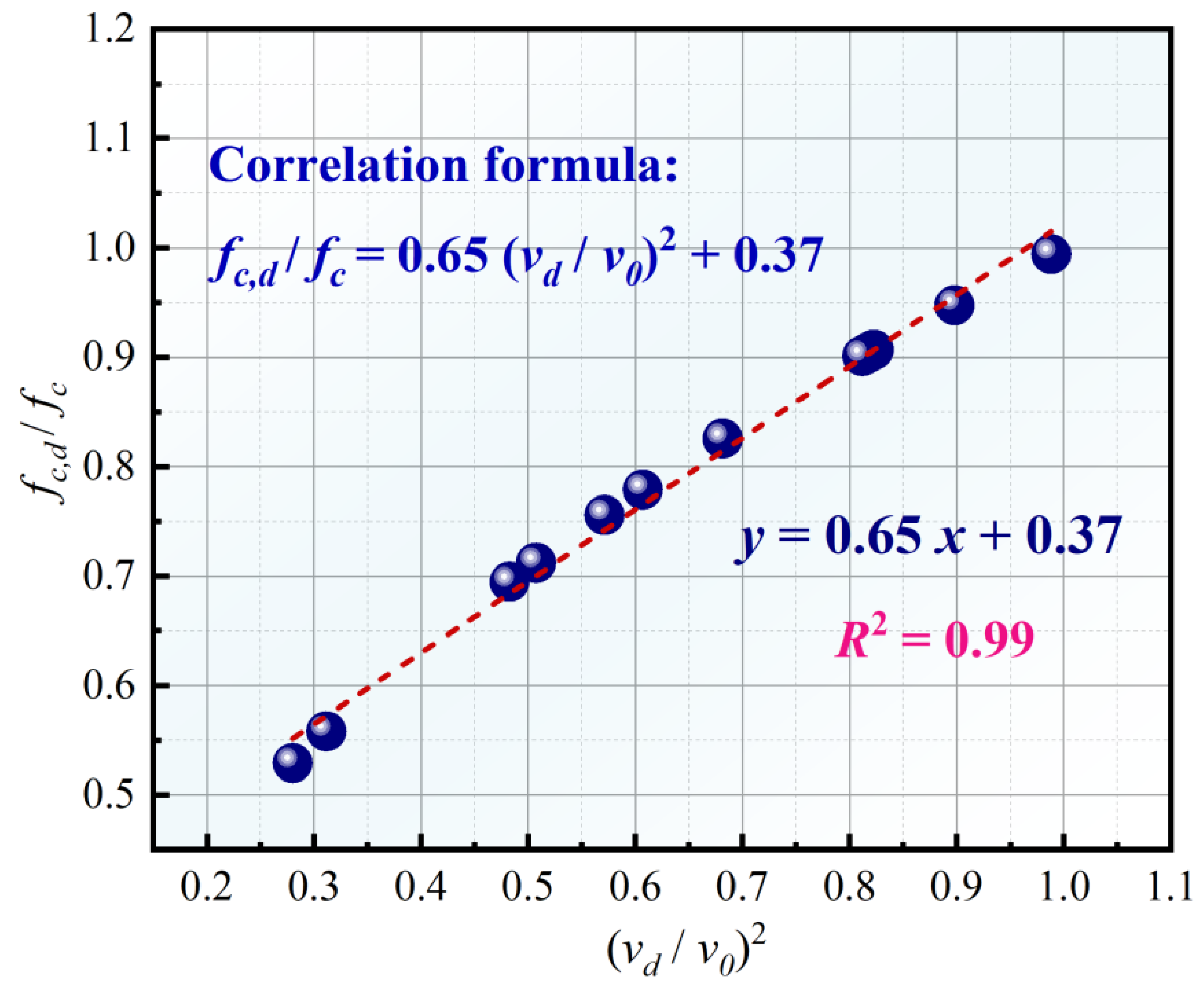

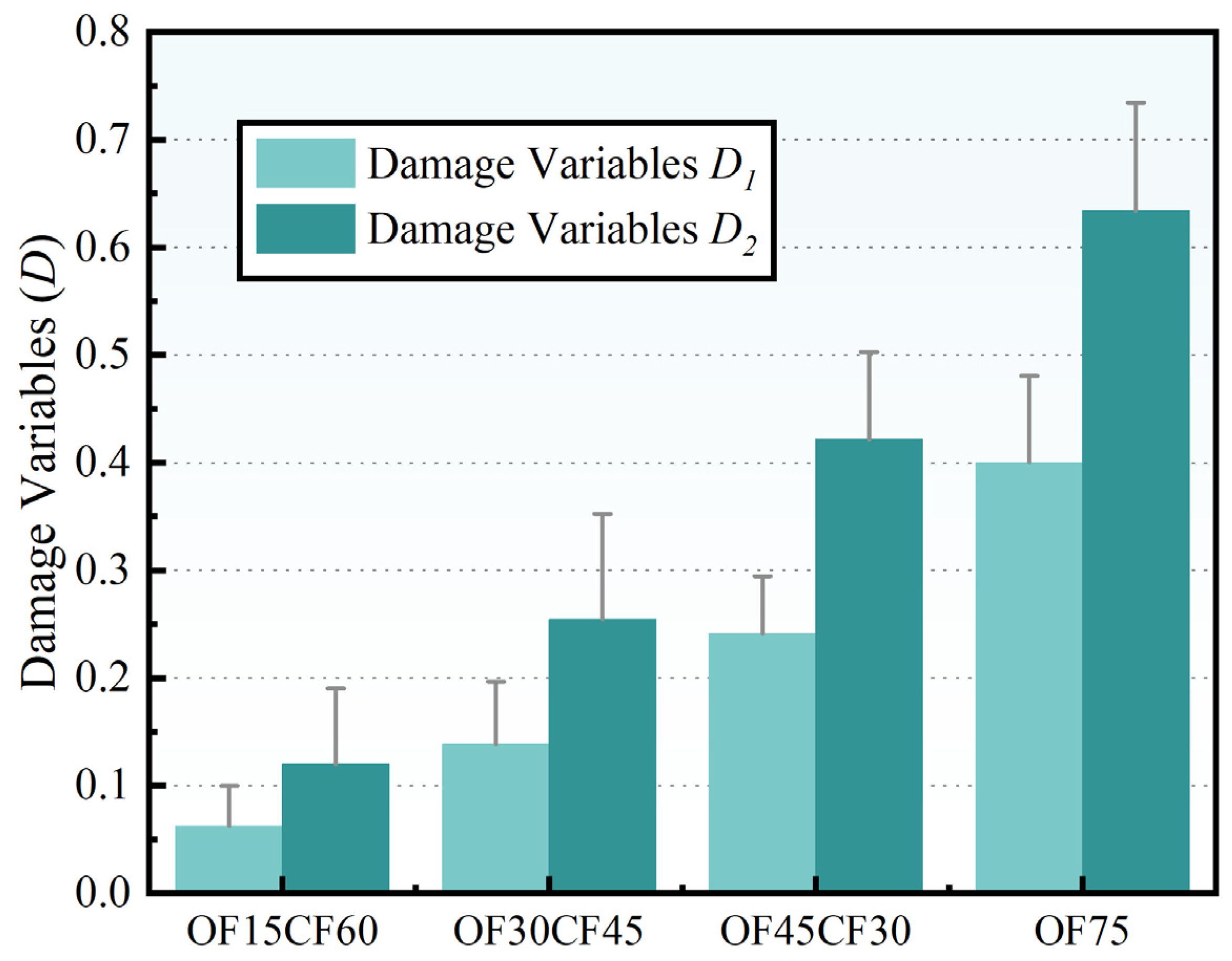
| W/C | C (kg) | W (kg) | S (kg) | G (kg) |
|---|---|---|---|---|
| 0.50 | 320 | 160 | 754.7 | 1132.5 |
| ID | Ultrasonic Testing and Compressive Strength Specimens | Water Absorption Test Specimens | ||||
|---|---|---|---|---|---|---|
| NS | NS-1 | NS-2 | NS-3 | - | - | |
| OF75 | OF75-1 | OF75-2 | OF75-3 | - | - | |
| OF15CF60 | OF15CF60-1 | OF15CF60-2 | OF15CF60-3 | OF15CF60-4 | OF15CF60-5 | OF15CF60-6 |
| OF30CF45 | OF30CF45-1 | OF30CF45-2 | OF30CF45-3 | OF30CF45-4 | OF30CF45-5 | OF30CF45-6 |
| OF45CF30 | OF45CF30-1 | OF45CF30-2 | OF45CF30-3 | OF45CF30-4 | OF45CF30-5 | OF45CF30-6 |
| Time | 60 s | 5 min | 10 min | 20 min | 30 min | 60 min | 1 h | Hourly Measurement | Daily Measurement | 4–7 Days | 7–9 Days |
|---|---|---|---|---|---|---|---|---|---|---|---|
| Tolerance | 2 s | 10 s | 2 min | 2 min | 2 min | 2 min | 5 min | 2 h | 2 h | 2 h | 2 h |
| Slice Numbering | Initial Mass m1 (g) | Mass after Drying m2 (g) | Mass after Water Absorption/Saturation m3 (g) |
|---|---|---|---|
| 1 | 573 | 537.8 | 570.9 |
| 2 | 542 | 509.8 | 539.6 |
| 3 | 542 | 510.4 | 545.5 |
| 4 | 524 | 492.0 | 526.3 |
Disclaimer/Publisher’s Note: The statements, opinions and data contained in all publications are solely those of the individual author(s) and contributor(s) and not of MDPI and/or the editor(s). MDPI and/or the editor(s) disclaim responsibility for any injury to people or property resulting from any ideas, methods, instructions or products referred to in the content. |
© 2024 by the authors. Licensee MDPI, Basel, Switzerland. This article is an open access article distributed under the terms and conditions of the Creative Commons Attribution (CC BY) license (https://creativecommons.org/licenses/by/4.0/).
Share and Cite
Wang, W.; Huang, Z.; Zhi, D.; Xia, P.; Gong, F.; Lin, P. Investigation of Opening and Closing Water Boundary Conditions on Frost Damage Development in Concrete. Buildings 2024, 14, 2451. https://doi.org/10.3390/buildings14082451
Wang W, Huang Z, Zhi D, Xia P, Gong F, Lin P. Investigation of Opening and Closing Water Boundary Conditions on Frost Damage Development in Concrete. Buildings. 2024; 14(8):2451. https://doi.org/10.3390/buildings14082451
Chicago/Turabian StyleWang, Wei, Zhe Huang, Dian Zhi, Peng Xia, Fuyuan Gong, and Peng Lin. 2024. "Investigation of Opening and Closing Water Boundary Conditions on Frost Damage Development in Concrete" Buildings 14, no. 8: 2451. https://doi.org/10.3390/buildings14082451






